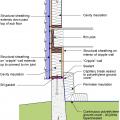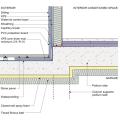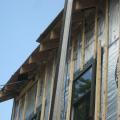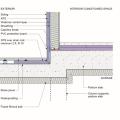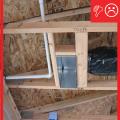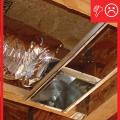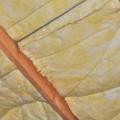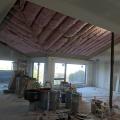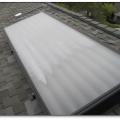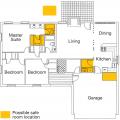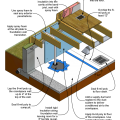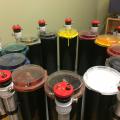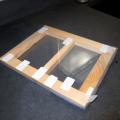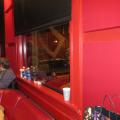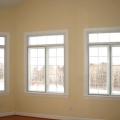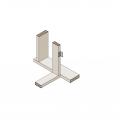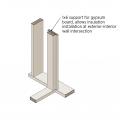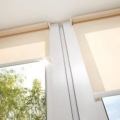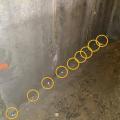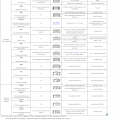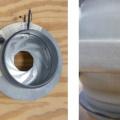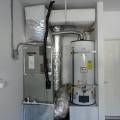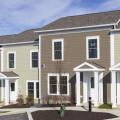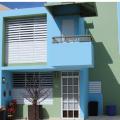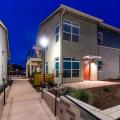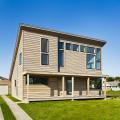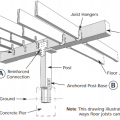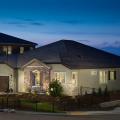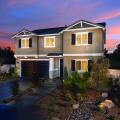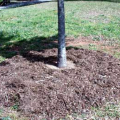Showing results 1751 - 1800 of 4973
Insulating a crawlspace foundation with “cripple wall” in warm climates; in Climate Zones 5+ replace the foil- or plastic-faced fiberglass batt/roll insulation with impermeable rigid insulation or closed-cell spray polyurethane foam
Insulating both exterior and garage-side faces of plaza deck can reduce thermal bridging. If garage is heated or partially heated, hybrid spray foam/batt insulation on garage side of plaza deck should extend to the perimeter of the garage.
Insulating sheathing is extended up to the roof rafters and sealed around the framing with spray foam as part of this exterior wall retrofit
Insulating sheathing is installed on exterior of an existing framed wall with water control between existing sheathing and insulating sheathing
Insulating the exterior and garage-side faces of the garage plaza deck can reduce thermal bridging. If the garage is heated or partially heated, the spray foam on the garage side of the plaza deck should extend to perimeter of garage.
Insulating the exterior and garage-side faces of the plaza deck can reduce thermal bridging. If the garage is heated or partially heated, the faced batt insulation on the garage side of the plaza deck should extend to perimeter of garage.
Insulation was added to the walls and ceiling of this existing home from the inside as part of an extensive retrofit to avoid replacing original 1-inch shiplapped sheathing.
Integrate pre-formed vent pipe flashing, shingle-fashion, with roofing underlayment and shingles
Interior and exterior footing drains keep moisture away from the foundation. Spray-on water proofing helps the concrete foundation walls resist moisture.
Interior non-load bearing walls are 2x4 studs spaced 24-inchon- center, can have non-structural connectors
Interior storm windows have very little impact on the appearance of the window, although the window frame may appear slightly wider
Interior wall attached with top plate metal connector, drywall clips support drywall, plan view
Interior wall attached with top plate metal connector, drywall clips support drywall, side view
Interior window attachments such as these light-filtering roller shades can reduce heat gains while providing pleasant, diffuse natural light.
Intermittent supply and exhaust fans rated at ≤ 3 sones by manufacturer, unless rated flow ≥ 400 CFM
Intermittent water leaks have been injection sealed to prevent water infiltration into the foundation.
Internet-enabled lighting controls are part of many home automation systems and can increase safety and security as well as energy efficiency.
Iris damper style airflow stations come in different sizes and can be adjusted to control airflow
It is not recommended to install HVAC systems in enclosed attached garages. However, when HVAC systems are installed in enclosed garages, they must comply with ASHRAE 62.2 duct leakage thresholds.
Ithaca Neighborhood Housing Services built this affordable home in the cold climate in Ithaca, NY, and certified it to DOE Zero Energy Ready Home specifications in 2013.
Jalousie windows use shutters rather than glass over the window openings to allow for maximum ventilation. Screens may be installed to keep out insects.
Jenkins Builders built this custom spec home in the mixed-humid climate in Nottingham, MD, and certified it to DOE Zero Energy Ready Home specifications in 2020.
John Hubert Associates' built this custom home in the mixed-humid climate in North Cape May, NJ, and certified it to DOE Zero Energy Ready Home specifications in 2014.
Joints between SIP panels can be connected with solid lumber splines or SIP panel pieces. SIP panel pieces help to ensure a continuous layer of insulation across the building shell.
Joist straps or hangers and metal connector plates can reinforce a post-and-pier foundation against seismic movement
Jump ducts are installed in the ceiling to connect closed rooms with open space to provide a return air path and balance air pressure
KB Home built this production home in the hot-dry climate in El Dorado Hills, CA, and certified it to DOE Zero Energy Ready Home specifications in 2015.
KB Homes built this production home in the hot-dry climate in Lancaster, CA, and certified it to DOE Zero Energy Ready Home specifications in 2014.
KB Homes built this production home in the hot-dry climate in San Marcos, CA, and certified it to DOE Zero Energy Ready Home specifications in 2013.
Keep mulch away from trunk of the tree to allow air circulation at the root collar.
Key connection points for a continuous load path for earthquake and high wind disaster resistance
